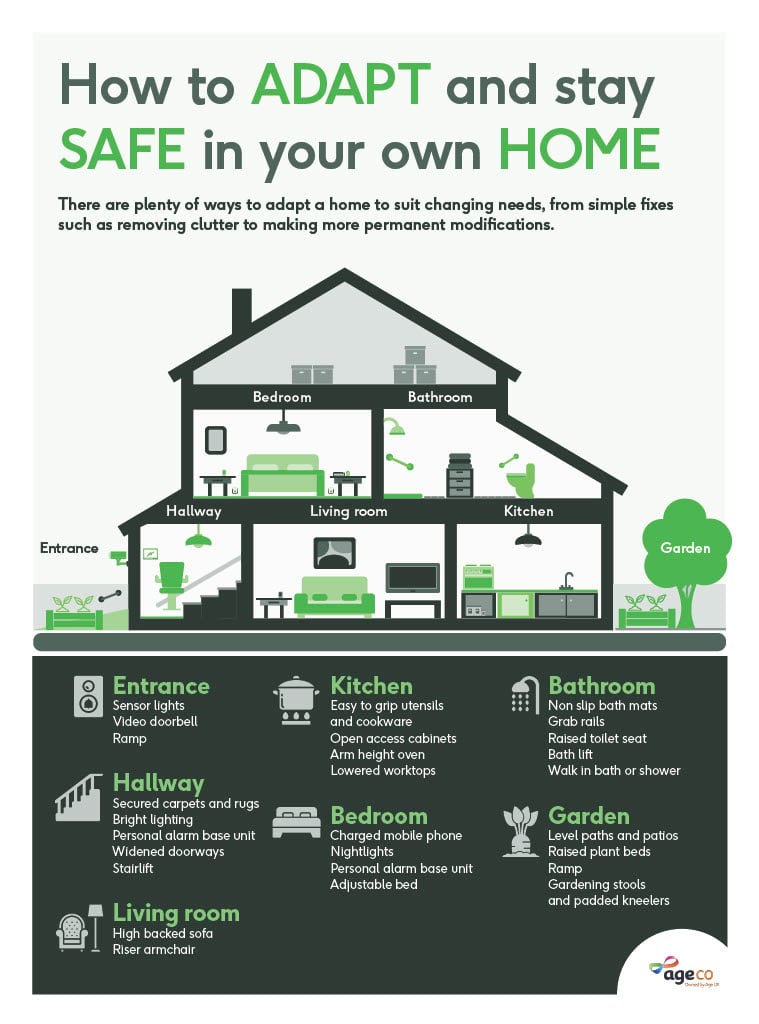Do I adapt my home or downsize?
4 minute read

Downsizing or moving home in later life is something that many people consider. However, for those who prefer to stay put there are plenty of ways to adapt a home to suit changing physical needs.

Independent Living Solutions
Home mobility aids, wearable alarms and personal care products to help you live independently, stay safe and feel confident.
Most people want to live independently for as long as possible. Continuing to stay safe and comfortable at home though can mean moving to a smaller or more suitable property. For some that is an exciting opportunity for change but for others, leaving the home they’ve loved and lived in for years is a decision they’d prefer not to take.
Love it: 10 ways to adapt a home for the future
The good news is there are plenty of ways to adapt a home to changing needs, from simple fixes to making more permanent modifications, such as:
1. Changing the furniture layout for ease of movement by replacing a coffee table in the middle of the room with side tables, for example.
2. Ensuring any carpets are properly fitted and secured, rugs are held in place with tape or non-slip matting with walkways and stairs kept free of trip hazards.
3. Ensuring lighting is clear and bright, both inside and outside the home, perhaps using sensors, remotes or voice-activated switches to help control lighting.
4. Swapping standard furniture for adjustable versions. Armchairs, sofas and beds can all be designed with special adaptive features to make getting in and out of them easier and more comfortable.
5. Widening doorways and adding ramps to make it easier to use a walking frame or wheelchair.
6. Fitting an electric bath lift or walk-in bath, adding grab rails or creating a single-level wet room to reduce the chance of slips and falls in the bathroom.
7. Making the garden easier to get around with single-level pathways and patios, and raising plant beds so they can be tended to with minimal bending or kneeling.
8. Installing a stairlift or homelift to make going up and down stairs easier – there are outside ones for gardens, too.
9. Adding a downstairs toilet or washroom will make it easier to access the facilities without the need to navigate stairs. It can also reduce the time needed to get there, which is helpful, should you experience incontinence.
10. Lowering cabinets, adjusting placement of ovens and appliances, and creating space under sinks and work surfaces for ease of reach by wheelchair users can all help make kitchens safer and more accessible.

There are lots of suppliers that provide home mobility products and adaptations from high-street brands to specialist shops. At Age Co we offer a range of bathing solutions, stairlifts and homelifts that could help transform your home.
Downsizing: types of accommodation to consider
Downsizing to save money or make daily life easier can be a good idea for some people. A smaller house should cost less to heat and be easier and can be cheaper to maintain than a larger property.
Bungalows can be a good choice for those prioritising mobility and easy access since all rooms are on one level, but these benefits also make them an in demand option so they can attract a higher price for their size relative to a traditional multi-storey home.
Sheltered housing and retirement flats are other options. The additional level of security they offer is popular with those with higher support needs.
Location, location, location
Location is another important consideration. Will the move bring family and friends closer and make social visits easier, or increase the need to travel? How easy is it to get to shops and cafes, or access essential services like the GP? It makes sense to think about how personal needs and priorities might change, so that any new home works in the long term too.
It’s also important to think about whether furniture and belongings will fit into new rooms (or stored in a garage), or whether buying different furniture is part of an exciting new stage of life.
What about personal alarms?
Even when a house is perfectly designed for those who live alone or have health concerns, a personal alarm can be a great help. It gives the wearer access to support at the touch of a button, 24 hours a day and provides loved ones with peace of mind too.
Personal alarms are usually worn as a pendant around the neck or on the wrist, like a watch. Should someone fall or feel unwell, one press connects them to someone who can help, whether that’s alerting a family member or arranging for emergency services to come out.
Age Co Personal Alarms
Age Co offer range of personal alarms designed to suit different needs allowing people to remain safe and independent in their own homes.
Many who choose to use a personal alarm service also install a key safe outside the home. This is a secure, coded lock box outside the home that holds a house key and means a trusted neighbour, carer or friend – or the emergency services – can get in if they need to.
Plan ahead and keep stress to a minimum
Moving or making changes to a home takes time and it’s wise to plan these things while in good health. Planning ahead means options can be thoroughly explored before making any decisions and changes will be in place in good time for when they’re actually needed.
For more advice on getting more out of your home during later life, try exploring the rest of our Useful Articles.

Sign up to the Age Co Newsletter
Each month, our email newsletter delivers inspiring stories, practical guides to later life, plus the latest news about Age Co and the charitable work we support.
